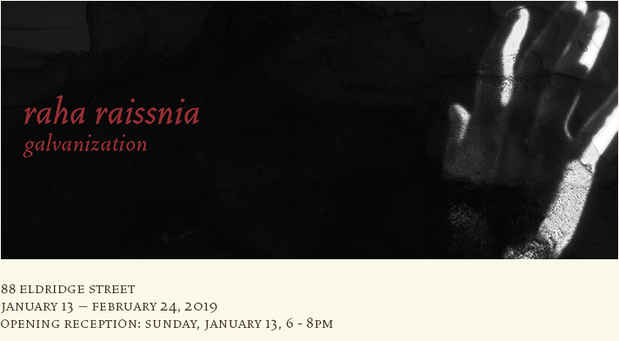Raha Raissnia “Galvanization”
Miguel Abreu Gallery (88 Eldridge St.)

This event has ended.
Miguel Abreu Gallery presents Galvanization, Raha Raissnia’s sixth solo exhibition at the gallery. The show will be on view at our 88 Eldridge Street location.
Raissnia will present new paintings and films, as well as a monumental multi-part work on paper, which expand on the body of work she initiated for her recent exhibition at the Drawing Center in New York. They take as their point of departure 35mm slides labeled “Sultanate Architecture” that she found in the visual resource archive discarded by Brooklyn College. The pictures depict the ruins of an abandoned 14th–century mosque.
As Amber Moyles writes in her essay for the Drawing Center show, Raissnia’s works “counter the function of photography presumed at its invention: the representation of an unequivocal image, one that bears a closed meaning that the observer can easily read. In the famed 1839 presentation to the French Chamber of Deputies, the physicist François Arago argued that the state should acquire the patent for the daguerreotype, an early photographic process, because the medium could be useful for surveying foreign territories and thus serve as a tool for expanding the imperial colonies. The photographers Luigi Pesce and Antoin Sevruguin, among others, sent images of the ruins of Persepolis in southwestern Iran to ethnographical societies and museums, fixing an image of Iran in a state of deterioration in the European Orientalist imagination. The clarity of images by Pesce and Sevruguin served to communicate an incontrovertible narrative to viewers, one that perpetuated stereotypes of the Middle East as falsely in need of Western protection.” While Raissnia also employs images of an archaeological site, in contrast, by cropping, erasing, superimposing and distorting them, her work opens up and complicates the possible denotations of the original photographs.
Driven by a desire to break away from the conventional cinematic screen, Raissnia’s looped 16mm films are projected through semi-transparent, hanging mobiles to create an architectural installation that both articulates the light as it moves through space and diffuses it through layers of screen and shadow. These cubic, lamp-like objects, placed at the center of the exhibition’s two main rooms, intercept the film projectors’ light beam and resemble hybrid sculptural objects, at once still and kinetic. The interplay of motion and stillness plays a central role in these seminal new works. The paintings and drawings, for their part, have a dense, filmic quality—they seem to press against their own stillness, challenge it—while Raissnia’s films superimpose static and moving imagery to the point of it becoming difficult to distinguish between the two.
The artist’s recent work is informed by her developing interest in the achievements of two photographers in particular: Henri Cartier-Bresson, and the lesser-known Abbas Attar. “From Cartier-Bresson, Raissnia notes, I learned about paying more attention to the geometry of forms in my compositions … to the rhythm, structure and the recognition of a certain order.” Her attention has also turned to Pier Paolo Pasolini: “The transforming awareness that Pasolini has stirred in me, is his tendency, as he said, to see something sacred, mythical, and with an epic quality in everything, even in the most simple and banal objects and events.”
Raissnia’s layered, archeological image does not sit comfortably with any potential definition of contemporary art. It escapes it, rather, by introducing memory formation as a primary force of seeing, feeling, and consciousness at large. As she states, “I am interested in the connectivity of everything, past and present.”
Raha Raissnia (b. 1968, Tehran, Iran) received her BFA from the School of the Art institute of Chicago in 1992 and her MFA from Pratt Institute in 2002. In the interim, her interest in avant-garde filmmaking led her to work at Anthology Film Archives (1995– 1999), where she has also exhibited. Raissnia presented a solo exhibition in 2017-18 at the Drawing Center (New York). In 2016, her work was the subject of a solo presentation at the Museum of Modern Art (New York). In 2015, Raissnia’s work was included in All the World’s Futures, the 56th Venice Biennial, curated by Okwui Enwezor. Previously, her work has been featured in exhibitions at White Columns (New York), Access Gallery (Vancouver), the Museum of Contemporary Art St. Louis, Khastoo Gallery (Los Angeles), Thomas Dane Gallery (London) and The Kitchen (New York), among others. Recent solo shows were held at Ab/Anbar Gallery (Tehran), Galeria Marta Cervera (Madrid), Galerie Xippas (Paris), and the Isfahan Museum of Contemporary Art (Iran). Raissnia’s projection- performances, often undertaken in collaboration with musicians Aki Onda and Panagiotis Mavridis, have been featured at the Whitney Museum of American Art (New York), REDCAT (Los Angeles), Arnolfini – Center for Contemporary Arts (Bristol), The Drawing Center, Issue Project Room, and Emily Harvey Foundation (New York), among others. Her work is held in the permanent collections of MoCA Los Angeles, The Museum of Old and New Art (Tasmania, Australia), Colección Inelcom (Madrid), and the Pinault Collection, among others. She will present a film and audio performance with Panagiotis Mavridis as part of Deep Focus: Blackout at the International Film Festival of Rotterdam in January.
Media
Schedule
from January 13, 2019 to February 24, 2019
Opening Reception on 2019-01-13 from 18:00 to 20:00